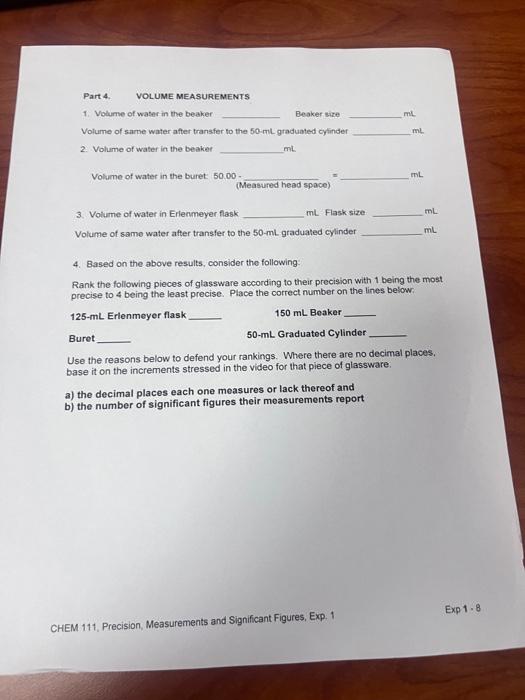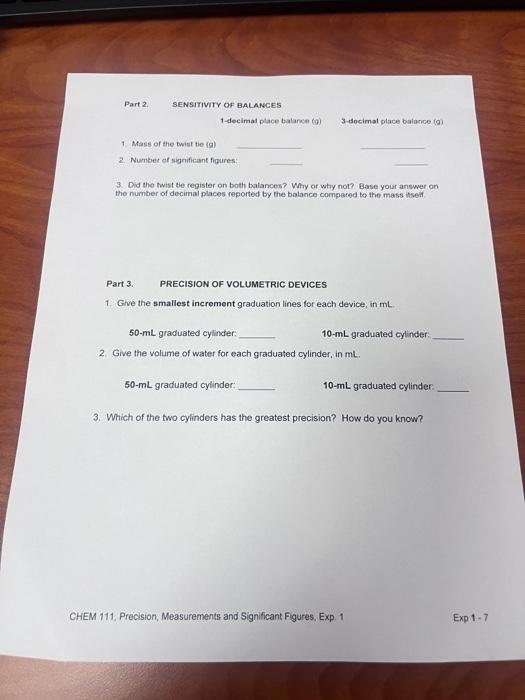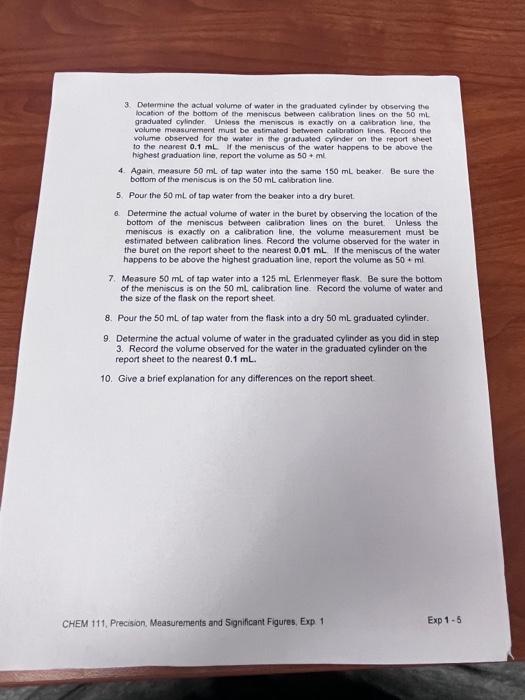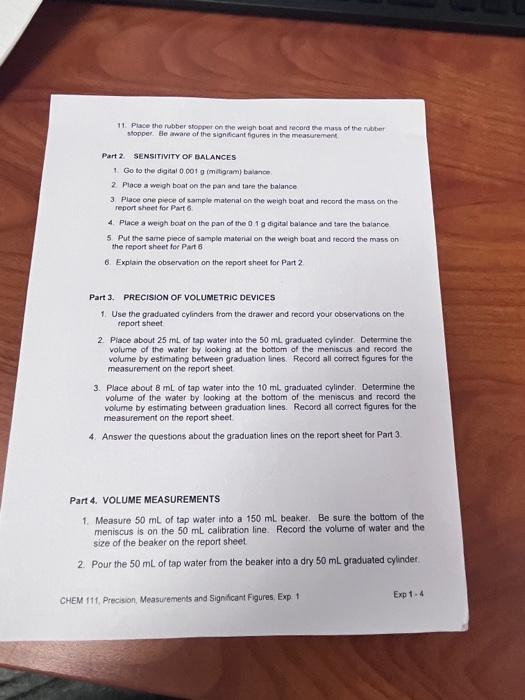Volume of same water after transfer to the 50mL graduated cylinder mL. 2. Volume of water in the beaker Volume of water in the buret: 50.00 - (Measured head space) mL 3. Volume of water in Erlenmeyer flask mL. Flask size min. Volume of samo water after transfer to the 50 - mL graduated cylinder mL 4. Based on the above results, consider the following: Rank the following pieces of glassware according to their precision with 1 being the most precise to 4 being the least precise. Place the correct number on the lines below: 125-mL Erlenmeyer flask 150mL Beaker Buret 50mL Graduated Cylinder Use the reasons below to defend your rankings. Where there are no decimal places. base it on the increments stressed in the video for that piece of glassware: a) the decimal places each one measures or lack thereof and b) the number of significant figures their measurements report 1. Mass of the Dwist tie (a) 2. Numbet of significant figures: 3. Bid the hwist tie register on both balances? Why or why not? Base your answer on the number of decimal places reported by the balance oompared to the mass tiveif. Part 3. PRECISION OF VOLUMETRIC DEVICES 1. Give the smallest increment graduation lines for each device, in mL 50-mL graduated cylinder: 10- mL graduated cylinder: 2. Give the volume of water for each graduated cylinder, in mL. 50-mL graduated cylinder: 10-mL graduated cylinder: 3. Which of the two cylinders has the greatest precision? How do you know? Name layonni broun Partrict (if applicubte) REPORT SHEET FOR EXPERIMENT 1 Part 1. PRECISION OF BALANCES Triple beam balance (2 decimal places) 1. Mass of weigh boat (g) 2. Mass of weigh boat and rubber stopper (g) 3. Mass of rubber stopper ( 9 ) 4. Number of significant figures the mass of rubber stopper Digital balance (2 decimal places) 5. Mass of rubber stopper (g) 6. Number of significant figures in the measurement Digital balance (1 decimal place) 7. Mass of rubber stopper (g) 8. Number of significant figures in the measurement 9. Which of the diaital balances is more precise for the measurements obtained? Why? Defend your answer based on the number of decimal places. CHEM 111, Precision, Measurements and Significant Figutes, Exp. 1 Exp16 3. Determine the actual volume of water in the graduated cylnder by observing the location of the botiom of the meniscus between calbration lines on the 50mL graduated oylinder Uniess the meniscus is exactly on a calbration line, the volume measurement must be estimated between calibration lines. Recoed the wolume observed for the water in the graduated oylinder on the report sheet to the nearest 0.1mL If the meniscus of the water happens to be above the highest graduation line, report the volume as 50+ml. 4. Again, measure 50mL of tap water into the same 150mL beaker. Be sure the: bottom of the meniscus is on the 50mL calbration line. 5. Pour the 50mL of tap water from the beaker into a dry busel. 6. Determine the nctual volume of water in the buret by observing the location of the bottom of the meniscus between calibration lines on the buret. Unless the meniscus is exactly on a calibration line, the volume measurement must be estimated between calibration lines. Record the volume observed for the water in the buret on the report sheet to the nearest 0.01mL If the meniscus of the water happons to be above the highest graduation line, report the volume as 50+ml 7. Measure 50mL of tap water into a 125mL. Erlenmeyer flask. Be sure the bottom of the meniscus is on the 50mL. cal bration line. Record the volume of water and the size of the flask on the report sheet. 8. Pour the 50mL of tap water from the flask into a dry 50mL graduated cylinder. 9. Determine the actual volume of water in the graduated cylinder as you did in step 3. Record the volume observed for the water in the graduated cylinder on the report sheet to the nearest 0.1mL. 10. Give a brief explanation for any difterences on the report sheet: 11. Place the nubber stopper on the weigh boat and recort phe mass of the notber stopper. He arware of the signicant figures in the measarertert Part 2. SENSITIVITY OF BALANCES 1 Go to the digital 0.001g (mitbgam) balance. 2. Ploce a weigh boat on the par and tare the balance 3. Place one piece of sample material on the weigh boat and record the mass on the reDort sheet foe Part 6 4. Place a weigh boat on the pan of the 0.19 digital balance and tare the balance: 5. Put the same piece of sample material on the werigh boat and tecord the mass on the report sheet for Part 6 : 6. Explain the observation on the report sheet for Part 2 . Part 3. PRECISION OF VOLUMETRIC DEVICES 1. Use the gradualed cylinders from the drawer and record your coservations on the report sheet. 2. Place about 25mL of tap water into the 50mL graduated cylinder. Determine the volume of the water by looking at the bottom of the meniscus and recond the volume by estimating between graduation lines. Record all correct figures for the measurement on the report sheet 3. Place about BmL of tap water into the 10mL graduated cylinder. Determine the volume of the water by looking at the bottom of the meniscus and record the voivime by estimating between graduation lines. Record all correct figures for the measurement on the report sheet. 4. Answer the questions about the graduation lines on the report sheet for Part 3 Part 4. VOLUME MEASUREMENTS 1. Measure 50mL of tap water into a 150mL beaker. Be sure the bottom of the meniscus is on the 50mL calibration line. Record the volume of water and the size of the beaker on the report sheet. 2. Pour the 50mL of tap water from the beaker into a dry 50mL graduated cylinder. CHEM 111, Precison, Measurements and Signficant Frgures. Exp-1 Exp 1.4 You wet ute batancet graituated cyinders and opets to makn meawaremints and describe the number of signticant fgures for each measirement. Thire are balances with unve different degrees of precoion avalabin 0.g.0.01g and 0.001g There are also ba0 ditlerent trpes of 0.01g for contigran) balances. alglat ars briple betam There are gradyated cylinders in the drawers with d flerent calpration markings. tise of the balarces wal be demonstrated OBJECTIVES - To recognize significant figures in a number and corvectly use signifieant figures in a calculation * To make a series of mass and volume fveusurements and record these measurements correctly with the proper number of slgnificant figures. EXPERIMENTAL PROTOCOL Meacieagles for al portions of this investigation. Part 1. PRECISION OF BALANCES (three balances: triple beam and two digital balances) 1. Zero the triple beam balance 2. Place a weighing boat on the pan and balance the mass of the weigh boat by adjusting the weights on the bears. 3. Determine the mass of the weigh boat from the locations on the balancing masses on the beams and recont the mass on the report sheet. You must estimater between calbration ines to correctly determine the mass 4. Place a nubber stopper in the weigh boat and determine the total mass by adjusting the weights on the beams. Recoed the total mass on the report sheet. 5. Calculate the mass of the rubber stopper by subtracting the mass of the weigh boat. Record the mass of the rubber stopper on the report sheel. 6. Zero the digital 0.019 balance. 7. Place a weigh boat on the pan and tare the balance to 0 8. Place the rubber stopper on the weigh boat and record the mass of the object. Be aware of the significant figures in the measurement. 9. Zero the digital 0.19 balance 10. Place a woigh boat on the pan of the digital 0.1g balance and tare the balance HEM 111. Precision, Messurements and Significant Fiqures. Exp 1 Exp13 Volume of same water after transfer to the 50mL graduated cylinder mL. 2. Volume of water in the beaker Volume of water in the buret: 50.00 - (Measured head space) mL 3. Volume of water in Erlenmeyer flask mL. Flask size min. Volume of samo water after transfer to the 50 - mL graduated cylinder mL 4. Based on the above results, consider the following: Rank the following pieces of glassware according to their precision with 1 being the most precise to 4 being the least precise. Place the correct number on the lines below: 125-mL Erlenmeyer flask 150mL Beaker Buret 50mL Graduated Cylinder Use the reasons below to defend your rankings. Where there are no decimal places. base it on the increments stressed in the video for that piece of glassware: a) the decimal places each one measures or lack thereof and b) the number of significant figures their measurements report 1. Mass of the Dwist tie (a) 2. Numbet of significant figures: 3. Bid the hwist tie register on both balances? Why or why not? Base your answer on the number of decimal places reported by the balance oompared to the mass tiveif. Part 3. PRECISION OF VOLUMETRIC DEVICES 1. Give the smallest increment graduation lines for each device, in mL 50-mL graduated cylinder: 10- mL graduated cylinder: 2. Give the volume of water for each graduated cylinder, in mL. 50-mL graduated cylinder: 10-mL graduated cylinder: 3. Which of the two cylinders has the greatest precision? How do you know? Name layonni broun Partrict (if applicubte) REPORT SHEET FOR EXPERIMENT 1 Part 1. PRECISION OF BALANCES Triple beam balance (2 decimal places) 1. Mass of weigh boat (g) 2. Mass of weigh boat and rubber stopper (g) 3. Mass of rubber stopper ( 9 ) 4. Number of significant figures the mass of rubber stopper Digital balance (2 decimal places) 5. Mass of rubber stopper (g) 6. Number of significant figures in the measurement Digital balance (1 decimal place) 7. Mass of rubber stopper (g) 8. Number of significant figures in the measurement 9. Which of the diaital balances is more precise for the measurements obtained? Why? Defend your answer based on the number of decimal places. CHEM 111, Precision, Measurements and Significant Figutes, Exp. 1 Exp16 3. Determine the actual volume of water in the graduated cylnder by observing the location of the botiom of the meniscus between calbration lines on the 50mL graduated oylinder Uniess the meniscus is exactly on a calbration line, the volume measurement must be estimated between calibration lines. Recoed the wolume observed for the water in the graduated oylinder on the report sheet to the nearest 0.1mL If the meniscus of the water happens to be above the highest graduation line, report the volume as 50+ml. 4. Again, measure 50mL of tap water into the same 150mL beaker. Be sure the: bottom of the meniscus is on the 50mL calbration line. 5. Pour the 50mL of tap water from the beaker into a dry busel. 6. Determine the nctual volume of water in the buret by observing the location of the bottom of the meniscus between calibration lines on the buret. Unless the meniscus is exactly on a calibration line, the volume measurement must be estimated between calibration lines. Record the volume observed for the water in the buret on the report sheet to the nearest 0.01mL If the meniscus of the water happons to be above the highest graduation line, report the volume as 50+ml 7. Measure 50mL of tap water into a 125mL. Erlenmeyer flask. Be sure the bottom of the meniscus is on the 50mL. cal bration line. Record the volume of water and the size of the flask on the report sheet. 8. Pour the 50mL of tap water from the flask into a dry 50mL graduated cylinder. 9. Determine the actual volume of water in the graduated cylinder as you did in step 3. Record the volume observed for the water in the graduated cylinder on the report sheet to the nearest 0.1mL. 10. Give a brief explanation for any difterences on the report sheet: 11. Place the nubber stopper on the weigh boat and recort phe mass of the notber stopper. He arware of the signicant figures in the measarertert Part 2. SENSITIVITY OF BALANCES 1 Go to the digital 0.001g (mitbgam) balance. 2. Ploce a weigh boat on the par and tare the balance 3. Place one piece of sample material on the weigh boat and record the mass on the reDort sheet foe Part 6 4. Place a weigh boat on the pan of the 0.19 digital balance and tare the balance: 5. Put the same piece of sample material on the werigh boat and tecord the mass on the report sheet for Part 6 : 6. Explain the observation on the report sheet for Part 2 . Part 3. PRECISION OF VOLUMETRIC DEVICES 1. Use the gradualed cylinders from the drawer and record your coservations on the report sheet. 2. Place about 25mL of tap water into the 50mL graduated cylinder. Determine the volume of the water by looking at the bottom of the meniscus and recond the volume by estimating between graduation lines. Record all correct figures for the measurement on the report sheet 3. Place about BmL of tap water into the 10mL graduated cylinder. Determine the volume of the water by looking at the bottom of the meniscus and record the voivime by estimating between graduation lines. Record all correct figures for the measurement on the report sheet. 4. Answer the questions about the graduation lines on the report sheet for Part 3 Part 4. VOLUME MEASUREMENTS 1. Measure 50mL of tap water into a 150mL beaker. Be sure the bottom of the meniscus is on the 50mL calibration line. Record the volume of water and the size of the beaker on the report sheet. 2. Pour the 50mL of tap water from the beaker into a dry 50mL graduated cylinder. CHEM 111, Precison, Measurements and Signficant Frgures. Exp-1 Exp 1.4 You wet ute batancet graituated cyinders and opets to makn meawaremints and describe the number of signticant fgures for each measirement. Thire are balances with unve different degrees of precoion avalabin 0.g.0.01g and 0.001g There are also ba0 ditlerent trpes of 0.01g for contigran) balances. alglat ars briple betam There are gradyated cylinders in the drawers with d flerent calpration markings. tise of the balarces wal be demonstrated OBJECTIVES - To recognize significant figures in a number and corvectly use signifieant figures in a calculation * To make a series of mass and volume fveusurements and record these measurements correctly with the proper number of slgnificant figures. EXPERIMENTAL PROTOCOL Meacieagles for al portions of this investigation. Part 1. PRECISION OF BALANCES (three balances: triple beam and two digital balances) 1. Zero the triple beam balance 2. Place a weighing boat on the pan and balance the mass of the weigh boat by adjusting the weights on the bears. 3. Determine the mass of the weigh boat from the locations on the balancing masses on the beams and recont the mass on the report sheet. You must estimater between calbration ines to correctly determine the mass 4. Place a nubber stopper in the weigh boat and determine the total mass by adjusting the weights on the beams. Recoed the total mass on the report sheet. 5. Calculate the mass of the rubber stopper by subtracting the mass of the weigh boat. Record the mass of the rubber stopper on the report sheel. 6. Zero the digital 0.019 balance. 7. Place a weigh boat on the pan and tare the balance to 0 8. Place the rubber stopper on the weigh boat and record the mass of the object. Be aware of the significant figures in the measurement. 9. Zero the digital 0.19 balance 10. Place a woigh boat on the pan of the digital 0.1g balance and tare the balance HEM 111. Precision, Messurements and Significant Fiqures. Exp 1 Exp13












